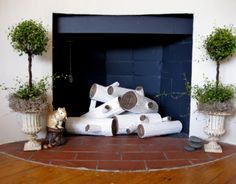 Saving a big money on the heating bills by sealing them off when not in use is possible from masonry fireplaces in the house. According to the U.S. Department of Energy, by sealing and weather-stripping fireplaces, a typical homeowner can reduce air leaks by up to 14% and save as much as $275 a year.
Saving a big money on the heating bills by sealing them off when not in use is possible from masonry fireplaces in the house. According to the U.S. Department of Energy, by sealing and weather-stripping fireplaces, a typical homeowner can reduce air leaks by up to 14% and save as much as $275 a year.
In general, fireplaces are so inefficient. While burning fireplace provides warmth and heated air, it lost up the chimney in the draft.there are air leaks around the edges of the damper. Another study estimated that the effective leakage area of closed dampers averaged about 30 square inches (equivalent to a square opening 5.5″ x 5.5″) in size allow continual flow of heated airto the outside.
In the heating season, with the flue damper closed, some of the valuable warm heated air is escaping up the chimney. The reason for this is the “chimney” or “stack” effect. Warm air in the house rises drawing cold air inside through cracks around windows, doors, vents and other places.
How to Seal You Masonry Fireplace
There are several products that are designed specifically for fireplace seals. This product can be installed easily or even it can be a do-it-yourself project. Here are three types of masonry fireplace draft sealers that can be easily purchased in-store or online.
- a balloon-shaped balloon that comes in many sizes, depending on your flue size,
- a rectangular-shaped balloon that presses up against your damper, and
- a fitted decorative cover over the fireplace opening
Another way to seal the masonry is by making one. Look up into the fireplace opening and note the shape of the opening just below the damper. That is where the damper seal will be installed. Measure each side of the opening just below the damper seal and transfer the measurements to a pattern drawn on cardboard. Cut out the pattern and put it in place to see if it fits. Make any adjustments to the measurements so that it fits tightly in place.
- Insulating foamboard seal. Transfer the final pattern to a piece of insulating foam board and cut out. Press the foamboard seal firmly in place just under the damper. Steel insulation springs can be used to help hold it in place.
- Plywood and insulating foamboard seal. Transfer the pattern onto a piece of plywood and cut out. Insert foam pipe insulation over the edges of the plywood. The pipe insulation will press against the bricks and provide a good seal. Glue rigid foam insulation on the plywood can be used in order to provide even more insulation.
Another simple way to seal the fireplace is by putting a fitted decorative cover over the fireplace opening.A metal fireplace screen can be used, and it is better if the cover fitted with magnets that attach the cover to the metal screen.
A friendly cautionary reminder, whether using a balloon-type seal or a rigid seal, always be careful not to inadvertently light a fire in the sealed fireplace. It is a good idea to place a small label on the fireplace noting that it is sealer have been put in place.
